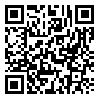BibTeX | RIS | EndNote | Medlars | ProCite | Reference Manager | RefWorks
Send citation to:
URL: http://irje.tums.ac.ir/article-1-5515-en.html
2- Associate Professor of Epidemiology, Department of Epidemiology, School of Public Health, Research Center for Health Sciences, Hamadan University of Medical Sciences, Hamadan, Iran ,
3- Associate Professor of Biostatistics, Department of Biostatistics, School of Public Health, Modeling of Noncommunicable Diseases Research Center, Hamadan University of Medical Sciences, Hamadan, Iran
4- Professor of Epidemiology, Department of Epidemiology & Biostatistics, School of Medicine, Kurdistan University of Medical Sciences, Kurdistan, Iran
Background and Objectives: Syndromic surveillance systems are used to early detection of outbreaks. The purpose of this study was to determine the feasibility of clinical and non-clinical data sources used in influenza syndromic surveillance in Zanjan.
Methods: In this time series study, clinical and non-clinical data related to influenza like illness (ILI) as a potential data source of syndromic surveillance systems, including the number of missed school days collected from 12 schools and the data of over the counter (OTC) drug sale obtained from 15 pharmacies selected randomly in Zanjan during 2014 were used. We used the line plot and moving average chart to explore trends and detect potential explainable patterns of data sources. The autocorrelation function and cross correlation function besides corresponding graphs were used to assess the feasibility of school absenteeism and OTC sale in timely detection of influenza outbreaks.
Results: Line plots indicated the presence of explainable patterns and the effect of the day of the week. The cross correlation value was 0.5 and cross correlogram revealed the similarity of both data sources in this study.
Conclusion: Our findings indicated the feasibility of influenza data sources, including school absenteeism and OTC, as potential data sources of syndromic surveillance systems.
Received: 2016/08/7 | Accepted: 2016/08/7 | Published: 2016/08/7
| Rights and permissions | |
 |
This work is licensed under a Creative Commons Attribution-NonCommercial 4.0 International License. |





